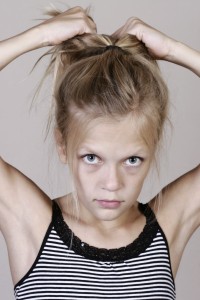Trichotillomania (TTM or Trich) in children is a condition where the child repetitively pulls out their own hair, resulting in noticeable hair loss. This hair pulling and the associated hair loss causes considerable distress or impairment in daily functioning (for the child or parent). Pulling hair excessively can sometimes result in serious medical problems, and lead to feelings of isolation, shame and confusion, particularly for older children. As a result many children or adolescents try to hide their difficulties and may be reluctant to get help.
Places children commonly pull hair from include:
- Scalp
- Eyebrows
- Eyelashes
TTM usually first presents around 9-13 years of age and reaches its peak between 12 and 13 years. There have also been cases of hair pulling in infants and toddlers (between 18 months and 3 years) which is sometimes referred to as “baby trich”. In these instances, TTM often occurs alongside other self-comforting habits such as thumb sucking.
Many children with TTM report experiencing a feeling of tension, itchiness, pain or tingling prior to pulling, leading to a strong urge to pull their hair. They then experience pleasure and relief from this sensation when pulling the hair. At other times children and infants may engage in automatic hair pulling without awareness of what they are doing. There is also sometimes a pre-pulling ritual such as feeling the hair and playing with it. This type of hair pulling is more likely to occur during sedentary activities such as watching television or times when they are tired or distressed. Many children also engage in post pulling rituals such as rubbing the hair between their fingers, examining the hair, and eating, chewing, or swallowing hair.
TREATMENT FOR CHILDREN
A comprehensive behavioural intervention called ‘Habit reversal training’ (HRT) has been shown to effectively reduce hair pulling, improve older children’s ability to cope with unpleasant thoughts, feelings and sensations and improve overall quality of life.
The main components of treatment are:
Awareness Training: This involves teaching the child to become more aware of the urges and triggers that happen prior to the hair-pulling. The young person then practices noticing the warning signs, and any real or simulated pulling. If the child or infant is too young to become aware themselves, then this part of treatment involves helping parents, caregivers, and teachers to become more aware of times that the child pulls their hair.
Competing Response Training: The child is helped to find a behaviour that is physically incompatible with the hair-pulling and that also satisfies some of their sensory needs that the hair pulling is fulfilling. For example, if hair-pulling occurs while watching television, a competing response might be to hold a toy that has a hair-like feel to it. In order to break the link between the urge to pull and the hair-pulling the child practices this behaviour (or the parent prompts the child to engage in this behaviour) when the urges or triggers to pulling are noticed or when the child or parent notices they have started pulling.
Stimulus Control: Factors in the environment that trigger the hair-pulling are identified and a problem-solving approach is taken to identify strategies to manage or avoid these environmental factors. For example, if hair-pulling occurs while looking in the mirror, mirrors may be removed or covered up for a period of time.
Social Support and Rewards: A support person (usually a parent) is chosen to praise the child when they use a ‘competing response’ instead of hair-pulling and to prompt these responses if the child hasn’t noticed that they are hair-pulling. A motivating reward system can also be implemented by the support person to increase the child’s motivation to use a competing response when they have an urge to pull their hair.
Managing Difficult Thoughts and Feelings: Older children with TTM often experience a number of other conditions including anxiety, low self-esteem, shame, self-consciousness, social isolation/rejection and depression. Cognitive Behavioural Therapy (CBT) can be used to teach young people strategies to cope with and manage the symptoms of these co-occurring conditions and to manage unpleasant thoughts, feelings and urges that are likely to lead to hair-pulling. This is particularly important as internal states such as stress and anxiety are likely to influence the frequency and intensity of focussed hair pulling.
Improving Quality of Life: Many young people have withdrawn from social relationships, study and other life activities as a result of their hair pulling behaviour and the feelings of shame associated with it. One goal of therapy is to assist with re-engaging in these activities and addressing difficult thoughts and feelings that may get in the way of this, in order to assist the young person to return to the tasks of normal childhood/adolescent development.
TREATMENT FOR BABY TRICH
At this stage, the child is largely dependent on their parents, so treatment is mostly structured and guided by the parent(s) in collaboration with the child psychologist. Many of the components of HRT such as stimulus control, competing response training and social support and rewards can be applied for young children and toddlers, along with preventative strategies such as wearing gloves or band-aids on the thumbs.
If you would like to find out more about our treatment for Trichotillomania, or to book an appointment with one of our child clinical psychologists who provides treatment for this condition, please email or call the clinic on 02 9438 2511.


